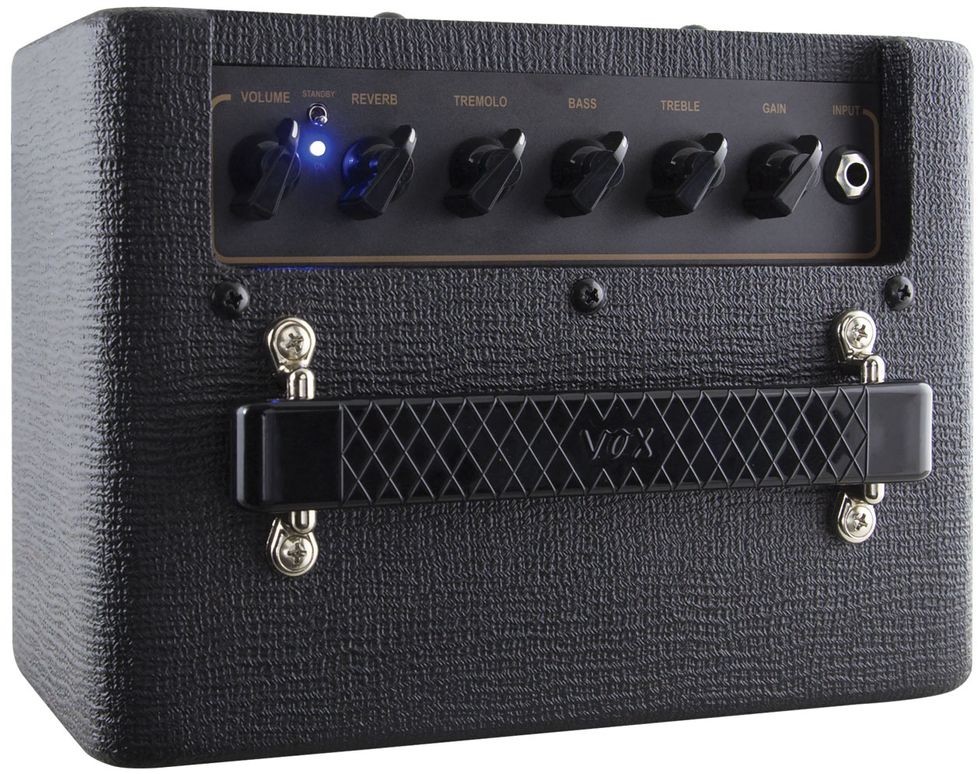RatingsPros:Lovely and rich jangle tones. Nice tremolo. Compact, with killer style. Head works well with other cabinets. Cons: Included speaker can make head sound more limited than it is. Where’s the trapezoid? Street: $329 Vox Mini Superbeetle voxamps.com | Tones: Ease of Use: Build/Design: Value: |
Believe it or not, there are cruel-hearted souls out there who think of the Beatles as a twee rock band. But take a look at a snapshot from the group’s 1966 U.S. tour—they look pretty tough with those 100-watt Vox Super Beatle amps towering behind them.
If you want to talk cute, well, the new Vox Mini Superbeetle—which pays homage to the original Super Beatle—is preposterously cute. It’s a 25-watt mini stack with a 1x10 cab and tiny, tremolo- and reverb-equipped head that nails the brand’s trademark jangle and can dish pretty tough tones, too, with the right guitar and pickups. And unlike the behemoth that inspired it, it won’t loom awkwardly like a monolith in your living room, require an ex-rugby player roadie, or demand a vintage amp technician on call 24-7.
Standing Stone Shrunk to Fit
With its streamlined and gleaming chrome stand, the Superbeetle cleverly channels the spirit of Vox’s beautiful and mod mid-’60s aesthetic. (Although if we’re being sticklers for authenticity, the rectangular, rather than trapezoidal, head and early-’60s badge style make the Superbeetle visually more akin to an AC-100 than a ’66 Super Beatle.) Nevertheless, the Mini looks super hip, and rivals a tweed Fender Champ for little-amp-as-interior-design-element appeal. It’s also light and easy to tote from room to room. If you’re measuring to figure out whether it will nestle nicely between the fern and the end table, it’s just under 13" wide and about 22 1/2" tall.
Like the recent Vox MV50 amplifiers, the Mini’s circuit uses Korg’s NuTube vacuum-fluorescent-display technology in the preamp section to stand in for a tube. While these slender components look more like glowing ICs than vacuum tubes, they function using similar principles—with glowing fluorescent elements taking the place of tube filaments—and do impart some of the dynamism and compression that tubes provide. (For those interested in a deeper look at Korg’s NuTube technology, there is ample documentation on the company’s website. It’s intriguing stuff.)
Though diminutive, the Superbeetle head is thoughtfully designed with some cool extras and features that enhance the amp’s utility, tonal range, and expressiveness. The control panel is simple and easy to navigate. Volume and gain knobs reside at either end of the control array, and bass and treble controls sit in between. The controls for the digital reverb and NuTube-driven tremolo are highly streamlined—the trem knob only controls rate, and reverb only regulates depth. The spring emulation sounds great in small doses, but does betray some digitalness at higher settings. The tremolo, meanwhile, is often lovely and immersive. It sounds just-right swampy and full at slow to medium rates, and nestles very nicely under fundamental tones at twitchier speeds.
The Mini’s back panel is also home to useful features. There’s an “eco” switch that automatically shuts the power off after a time, two 1/4" speaker outs, and a 1/4" headphone/line out that can be used with a DAW. There’s also a 3-position impedance switch (the amps actually runs at a full 50 watts of power at 4 ohms) and an EQ slider that moves from a flat voice (recommended for large cabinets) to a deep one designed to work with the stock 1x10 cabinet.

Jangle ’n’ Grit
There is much that is classically Vox-y about the Superbeetle’s sounds. For starters, the amp seems happiest and most alive at brighter EQ settings where high harmonics can color and dance around the fundamentals. Treblier settings also dovetail nicely with the more robust tones from the deep mode. However, the tendency to sound better at brighter settings does mean certain single-coils can sound thin and boxy compared to humbuckers, which seem like a best match for the Superbeetle. You should check out the Superbeetle with your own favored instruments to see if you agree, but I’d be inclined to say Les Paul players will be more immediately rewarded by the Superbeetle’s palette than Stratocaster devotees.
The amp’s gain also imparts a very Vox-like grit that evokes AC-style low- to mid-gain distortion. At less trebly settings, it can even generate the nasal-but-punchy tones Mike Campbell and Tom Petty used to extract from their full-size Super Beatles in the late ’70s. But when you dial in just the right amount of gain and high end, the Superbeetle achieves the brand’s trademark sounds in marvelous fashion—making chord arpeggios sound simultaneously muscular, chiming, and airy, and peppering lead lines with clear cayenne heat. These best sounds can sound even better through additional cabinets. I tried the Superbeetle with a Warehouse G12 C/S-equipped 2x12 and a 4x12 with Celestion Vintage 30s. In both cases, the little Superbeetle head sounded richer, more dimensional, and happier for the higher headroom
The Verdict
Dressed up in classic mid-’60s Vox motifs, the Mini Superbeetle is a gas just to look at. But it’s full of sonic surprises, too—from its sparkling, just-barely-dirty jangle to its throbbing tremolo. Experiments with other cabinets suggest a speaker upgrade could distinctly improve the performance of the stock head-and-cab combination. But at this price, the super-sharp aesthetics and surprisingly rich array of tones make it hard to complain about the sounds, style, value, portability, and potential this little stack delivers.
Watch the Review Demo:








![Rig Rundown: Russian Circles’ Mike Sullivan [2025]](https://www.premierguitar.com/media-library/youtube.jpg?id=62303631&width=1245&height=700&quality=70&coordinates=0%2C0%2C0%2C0)

















